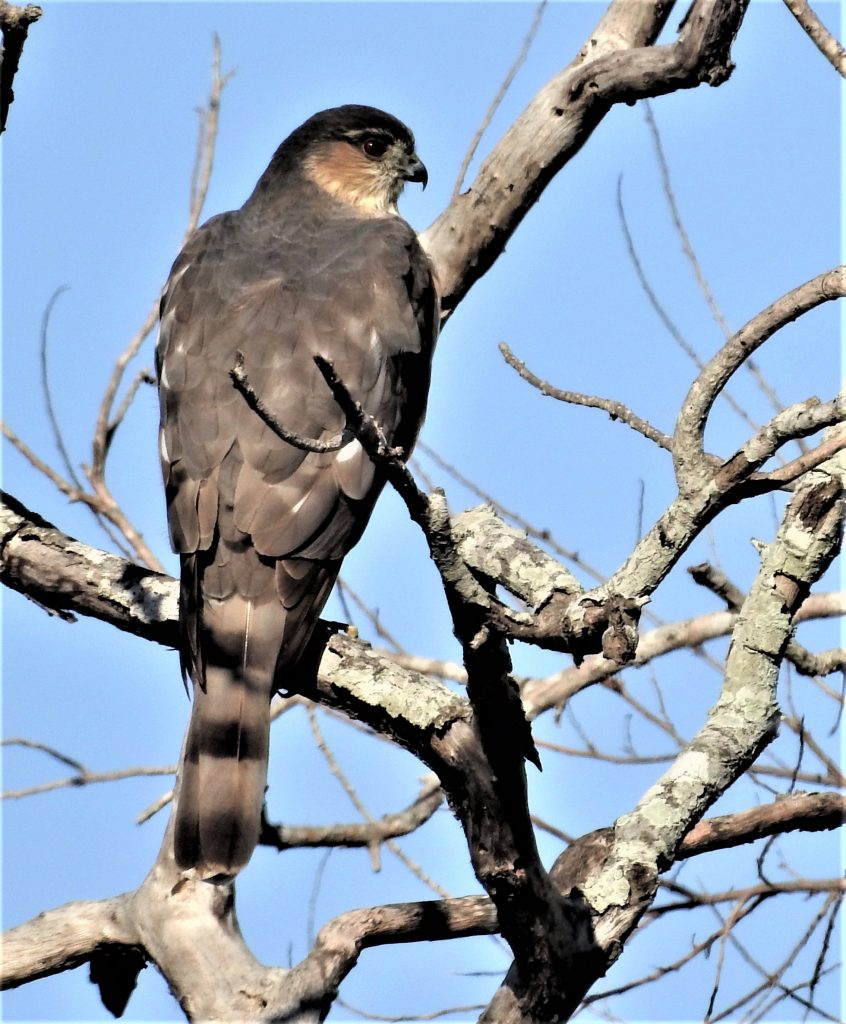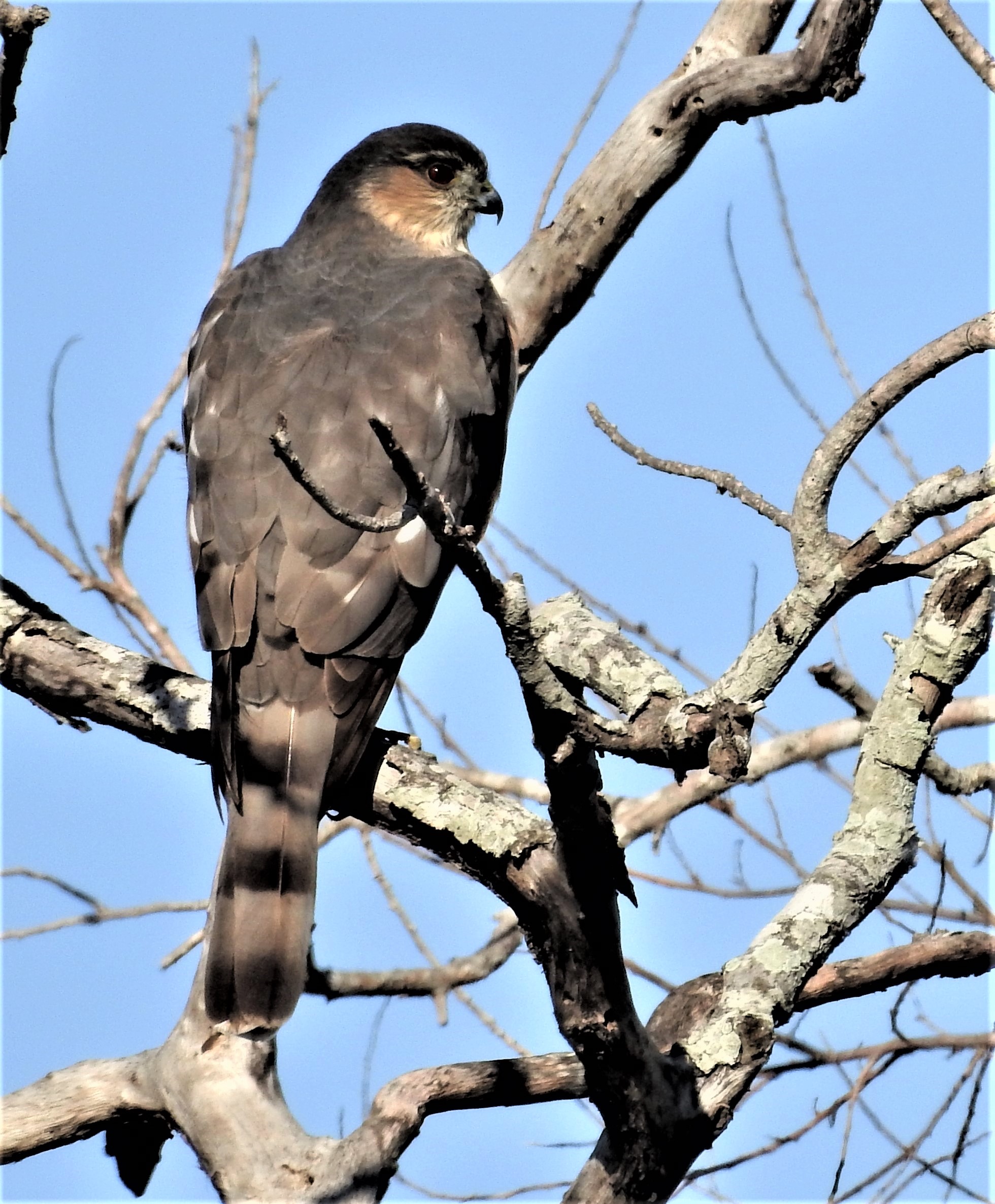by M. Kathy Raines
“Where are our birds?” I cried. Last winter, Cardinals and Green Jays joined our usual customers—House Sparrows, Curve-billed Thrashers, Black-crested Titmice, various doves — on the lawn or branches, at the feeder and among papery bamboo leaves. I opened my window so my cat and I could enjoy their morning calls and chatter. Now, I gazed upon eerily silent, bare limbs, devoid of all but an occasional sparrow or, when I set out peanut butter, a few Golden-fronted Woodpeckers and Great Kiskadees—whose heft may enhance their confidence.

Were birds happily feeding elsewhere on insects or naturally produced seeds and fruit? Perhaps. Had birds become ill? Poisoned? Had our house exterminator ventured too far into the yard? Cats? Not likely. They don’t know our boisterous lab has become senile. Ah, were we harboring a hawk? Then I recalled a sudden flurry of wings and a possible pursuit by a dove-sized bird, but, unaware of how small hawks can be, I pooh-poohed this, attributing it to regular jostling at the feeder.
Then, one morning, I saw it—a Sharp-shinned Hawk, on a branch, half-veiled by olive leaves, plucking, tearing and devouring a sparrow morsel-by-morsel, frequently looking up, then continuing its chore. It returned for a morning or two. Then it, or another, appeared across the street, then a couple blocks down. During the Great Backyard Bird Count, when I zoomed in on what I thought was a Northern Mockingbird alighting in our olive tree, I was astonished to see a dark, hooked beak; it was, rather, a Sharp-shinned Hawk tucked into the greenery. As I attempted to take its photo, though, it vanished like smoke; I never heard or saw it flap away.
I’m enchanted by hawks, and the backyard birds, in becoming scarce, are doing what they must. I hope, though—since most bird-eating hawks return to their northern breeding grounds—our usual birds, as well as vivid spring migrants, will indeed reappear. Songwriter Joni Mitchell asked, with perennial relevance, “Don’t it always seem to go, that you don’t know what you got till it’s gone?” After this temporary deprivation, I’ll warmly welcome squealing Great-tailed Grackles and the throngs of raucous, ravenous Red-winged Blackbirds due sometime in March.
Prior to consulting knowledgeable birders on Facebook’s Rio Grande Valley Birding site, I assumed this raider to be the more notorious Cooper’s Hawk, another diminutive migrant with a penchant for small birds. In fact, Sharp-shinnedHawks, or Sharpies, though somewhat smaller than Cooper’s Hawks, are almost indistinguishable from them. While a Cooper’s is crow-sized and a Sharpie, the size of a jay, a female Sharp-shinned may be as large as a male Cooper’s, since female hawks outsize males. A Sharpie’s head is more rounded, smaller and less dome-shaped than a Cooper’s, and its tail is straighter-edged. A Sharp-shinned wears grayish and dark feathers on its head and neck, while a Cooper’s are lighter. A juvenile of either species has yellow eyes, while adult eyes are red.
The Sharp-shinned Hawk (Accipiter striatus), North America’s smallest hawk, joins the Cooper’s and Northern Goshawk as the only three North American raptors in the genus Accipiter, which includes long-legged hawks with short, rounded wings—highly maneuverable birds that use their long tails like rudders. “Accipiter” is Latin for “hawk”, while “striatus” likely refers to the underside streaks on juveniles. The Sharp-shinned Hawk’s name stems from a sharp ridge on its legs.
A solitary stealth hunter, a Sharpie sits, partially concealed, on a branch or occasionally, the ground, and awaits attainable prey—a perched or ground-feeding bird or one on the wing. Then, astonishingly, it bursts forth, deftly flying through webs of branches and foliage, using its lengthy tail as a rudder. With long toes armed with deeply curved talons, it stabs and secures its victim. Seated on a branch, raised root or the ground, it plucks, then eats it. A Sharpie may also cruise hunt, hiding in vegetation and flushing out prey. A speedy short-distance flier, it gives up on prey that it doesn’t capture quickly. About 90% of the Sharpie’s prey is warbler-sized. Though this small hawk has been villainized as and even dubbed “chicken hawk,” it likely does not concentrate on such hefty prey. While dining primarily on birds, the Sharp-shinned may also eat small mammals, frogs, lizards and insects.
In their northern breeding grounds, Sharp-shinned Hawks prefer dense, primarily coniferous forests but are less choosy with winter grounds. They breed in Alaska and Canada and as far south as southern Alabama, New Mexico, Arizona and California. They migrate long distances, but some are now wintering farther north, perhaps due to milder winters and the proliferation of feeding stations along their paths, which offer up ready meals.
Once viewed as a tyrant—John James Audubon himself called it a “marauder”—the Sharp-shinned, along with other hawks, was not protected by the Migratory Bird Treaty Act of 1918 until an amendment passed in 1972. Ravaged, it appears, by shell-thinning DDT, as well as being frequently shot, numbers seriously declined, then rebounded, with some ups and downs, and the hawk is now considered “Of Least Concern” by the International Union for the Conservation of Nature (IUCN).
Being small, Sharp-shinned Hawks—and especially their young—are vulnerable to raptors such as owls, but their concealed nests and general secretiveness may protect them. Some Sharpies have died near vineyards and oil refineries due to chemical ingestion. Also, they, like other birds, crash into windows and are run over by vehicles.
As an equal-opportunity birder, I welcome the occasional hawk—especially knowing that it will likely migrate away this spring. However, birders can dissuade a hawk, most conveniently, by temporarily removing feeders. They can also use a caged, roofed or umbrella-ed one that prevents spillage, since ground birds make easy prey. Also, they might construct a brush pile, 20 feet off, if possible, as a retreat for victimized birds.


Leave a Reply